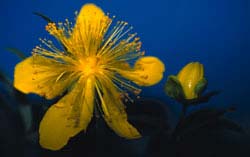Flower Chemicals Both Attract Friends and Deter Foes

Talk about multi-tasking. A new study reveals that in the St. John’s Wort plant, Hypericum calycinum, the same chemical not only attracts pollinating insects but also deters herbivores that pose a threat to its survival. The findings appear in the current issue of the Proceedings of the National Academy of Sciences.
To the human eye, the flowers of H. calycinum appear as uniform yellow disks (top image). Insects with ultraviolet-sensitive eyes, however, see a dark, ultraviolet-absorbing center (bottom image), which acts as a bull’s-eye to help the insects narrow in on the nectar. According to the new research, one class of pigments responsible for this UV pattern is dearomatized isoprenylated phloroglucinols, or DIPs. The investigators also found high concentrations of DIPs on the plant’s reproductive structures, which suggest that the chemicals serve additional purposes in the plant. “Just as important as attracting pollinators to a plant is producing a viable seed,” team member Matthew Gronquist of Cornell University explains, “so there is an evolutionary incentive to protect the reproductive apparatus from herbivores.”
Indeed, the scientists found that hypercalin A, one of the DIPs isolated from H. calycinum, deterred larvae of the rattlebox moth. Those caterpillars unlucky enough to ingest the hypercalin A died. The researchers conclude that DIPs act simultaneously to draw pollinators and discourage predators. “Now that we know where to look,” study co-author Thomas Eisner remarks, “antifeedant chemicals like the DIPs undoubtedly will be found in other plant species, and they offer clues to more natural insect control agents.”
Media Contact
All latest news from the category: Life Sciences and Chemistry
Articles and reports from the Life Sciences and chemistry area deal with applied and basic research into modern biology, chemistry and human medicine.
Valuable information can be found on a range of life sciences fields including bacteriology, biochemistry, bionics, bioinformatics, biophysics, biotechnology, genetics, geobotany, human biology, marine biology, microbiology, molecular biology, cellular biology, zoology, bioinorganic chemistry, microchemistry and environmental chemistry.
Newest articles

Webb captures top of iconic horsehead nebula in unprecedented detail
NASA’s James Webb Space Telescope has captured the sharpest infrared images to date of a zoomed-in portion of one of the most distinctive objects in our skies, the Horsehead Nebula….

Cost-effective, high-capacity, and cyclable lithium-ion battery cathodes
Charge-recharge cycling of lithium-superrich iron oxide, a cost-effective and high-capacity cathode for new-generation lithium-ion batteries, can be greatly improved by doping with readily available mineral elements. The energy capacity and…

Novel genetic plant regeneration approach
…without the application of phytohormones. Researchers develop a novel plant regeneration approach by modulating the expression of genes that control plant cell differentiation. For ages now, plants have been the…





















